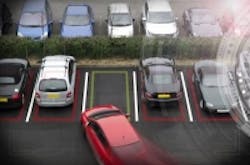Smart parking system uses machine vision to monitor parking lot occupancy
Product design and development firm Cambridge Consultants and semiconductor design and manufacturing company Analog Devices have developed a smart parking system that usesmachine vision to monitor and optimize parking lots.
The system combines low-costcameras integrated into a Blackfin Low-Power Imaging Platform (BLIP2) processing platform. The BLIP2 device is a low-cost, low-power embedded vision platform that features a Blackfin processor and Analog Devices’ optimized software library deliverables. BLIP2 features two imagers, the first of which is the OVM7692 SoC sensor with integrated lens from OmniVision, which is a 640 x 480 CMOS camera cube chip. The other imager in the BLIP2 platform is an ASX340 from ON Semiconductor, which is a 640 x 480 CMOS NTSC/PAL digital image SoC with overlay processor.
Additionally, an algorithm modified by Cambridge Consultants to suit the application needs as well as the camera resolution and field of view of the system runs on the BLIP2 platform, and is used to calculate with parking spaces are occupied or empty, without the disruption or expense of digging up roads and car parks to install individual sensors and communications for each parking bay.
"Our unique smart system uses machine vision to establish whether each space is free or occupied – with no need for expensive infrastructure," said Dipak Raval, a commercial director at Cambridge Consultants. "It’s an excellent example of how machine vision can provide a cost-effective way of monitoring occupancy over a wide area, since the camera is able to 'see' multiple bays."
Cambridge Consultants’ expertise in algorithm development enabled the team to ensure that the technology works in a variety of lighting conditions, and can cope with different vehicle sizes– without giving misleading results if pedestrians are standing in a parking space, for example, or shopping trolleys are left behind, said Raval.
With this system, motorists can be assigned a parking space as they enter a lot, enabling them to go straight to their allotted spot. Furthermore, motorists can request a specific spot in advance, and if data from the occupancy sensor is combined with number plate recognition, drivers could also be offered automated payment and help with locating their parked car, suggests Cambridge Consultants.
Michael Murray, general manager of industrial IoT and sensing at Analog Devices also commented on the collaboration.
"We‘re excited to collaborate with Cambridge Consultants on this project. The company’s world-class expertise in complex algorithm development allowed us to algorithmically enable BLIP for an application space that would create a unique solution to relieve a major source of frustration for drivers everywhere."
View apress release on the system.
Share your vision-related news by contactingJames Carroll, Senior Web Editor, Vision Systems Design
To receive news like this in your inbox, click here.
Join ourLinkedIn group | Like us on Facebook | Follow us on Twitter
About the Author

James Carroll
Former VSD Editor James Carroll joined the team 2013. Carroll covered machine vision and imaging from numerous angles, including application stories, industry news, market updates, and new products. In addition to writing and editing articles, Carroll managed the Innovators Awards program and webcasts.
